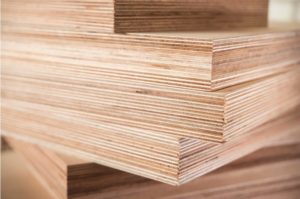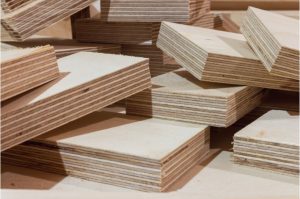Plywood is a solid sheet made of thin layers of wood glued together. The thin layers are made from small grains of wood running at an angle to provide a stiff condition and eliminate any movement in the timber.
 For plywood to remain stable, it’s usually made with three or five thin sheets called three-ply and five-ply respectively. Each layer in the plywood should be of similar material and thickness. The thicker the plywood is, the stronger it is and the less flexible it will be. The central part of the plywood may be thicker than the rest of it, but the opposite should never be the case. However, flexible plywood is sometimes recommended in creating curved components.
For plywood to remain stable, it’s usually made with three or five thin sheets called three-ply and five-ply respectively. Each layer in the plywood should be of similar material and thickness. The thicker the plywood is, the stronger it is and the less flexible it will be. The central part of the plywood may be thicker than the rest of it, but the opposite should never be the case. However, flexible plywood is sometimes recommended in creating curved components.
How Many Types of Plywood Are there?
In the plywood industry, there are many types which differ from each other by strength and quality. One of them is shuttering plywood. It is the cheapest type, but it still meets the building standards. It is used for boarding or sometimes put into place to shape poured concrete. Even though it can legally be used in construction, it has poor quality layers and may have defects. It can also spoil fast if exposed to water. The other type is the marine plywood. This is the most expensive and is of the highest quality. It is made up of hardwood layers and can be used for external purposes.
How to Cut Plywood
For the best results, plywood should be cut using electric saws. The fact that it is made of real wood could cause shuttering if a hand-held saw is used. Here are some instructions on how to cut plywood:
- Use a crosscutting blade with an alternate top angle. A crosscutting blade that has triple chip teeth would be an added advantage as it would give a perfect cut.
- Use a sacrificial board below the plywood you are cutting. This reduces the breakout of plywood on the other side.
- Use a marker or a utility knife to mark the cutting points before using the blade. This helps a lot in reducing the chances of wasted plywood to miscalculated positioning of the blade.
- It is recommended that flexible plywood is placed between two other sheets while cutting or an excellent blade used. Failure to this would make it spoil.
Plywood Industry Standards
 When it comes to using plywood in the construction industry the updated standard for all wood-based panels and joinery, EN 13986, stipulates that both internal and external use plywood must adhere to any of the three performance classes within the EN636 standard.
When it comes to using plywood in the construction industry the updated standard for all wood-based panels and joinery, EN 13986, stipulates that both internal and external use plywood must adhere to any of the three performance classes within the EN636 standard.
Plywood merchants and suppliers must provide evidence to prove that their products adhere to the specified standards. For instance, if you previously supplied weather-proof or exterior quality wood for use in the construction sector, you must specify that it complies with EN636, Class 3 standard.
Likewise, if you had previously purchased or supplied moisture-resistant wood for use in construction, you must ensure that it complies with the EN636, class 1 standard. The requirements for each class can be summarised as follows:
- Plywood for Dry Conditions
This refers to top plywood that is specifically for internal applications with minimum exposure to moisture. Applicable standards for this type of plywood include the EN636 Class 1, EN 314-2 Class 1 that defines plywood quality, EN 310 for bending test, and the EN 13986 for all wood-based panels used in construction. Plywood for use in dry conditions is ideal for all internal joinery, pipe boxing, doors, flooring underlay, and a wide range of weight saving applications.
- Plywood Humid Conditions
The EN 636-2 standard applies to plywood that is to be used in humid conditions characterised by relatively high moisture content and a temperature of below 20oC. The surrounding relative humidity must exceed 85% for a few months in a year. This type of plywood is suitable for internal use to construct floors, walls, linings, roof decking, and even flooring underlay. The other applicable standards include the EN 13986 for wood-based panels, EN 335 for durability and the EN 314-2 for plywood quality.
- Plywood for Exterior Use
The plywood for exterior use standards defines plywood to be used in specific climatic conditions that lead to extremely higher moisture content and other exterior climatic conditions. Such plywood can be used for both internal and external joinery which can be subjected to long term exposure to wetting and extreme heat. The applicable standards include the EN 636 Class 3, EN 335, EN 310, and the EN 13986.
Where to Buy Plywood
Plywood is mostly used for building purposes. If you are looking forward to building a home, the plywood used should be of high quality for best results. There are many retail stores to buy from but not all sell plywood of the best quality. One of the best stores to shop for these products is right here at Theo’s Timber Ltd. This company serves as a merchant and wholesaler for timber. They are well known for supplying the products in Manchester and the North West, UK. Some of the benefits of choosing Theo’s Timber Ltd are that we sell top quality plywood and have an extensive offer on other types of timber that you may be interested in such as chipboards, laminates and hardwood that all come in handy when building.
